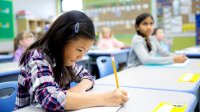A Valuable Tool for English Language Learners
Portfolios provide great benefits to students writing in their second language, allowing them to see their progress toward their goals.
Your content has been saved!
Go to My Saved Content.Writing is one of the most challenging skills to master in school. Compound this challenge by asking a student to write in their second or third language while meeting benchmarks and grade-level standards, and it’s no wonder writing appears to be such a daunting task for many English language learners, resulting in classrooms filled with apathetic and unmotivated students.
Portfolios are assessment tools designed to address these issues by placing students in the driver’s seat. The benefits of portfolios are well-documented in both theory and practice: (1) Students are able to select pieces of writing that showcase important milestones in their learning trajectory; (2) students take ownership of their learning through consistent goal-setting, reflection, and other metacognitive processes; and (3) students develop self-regulation skills that empower them with agency. But can portfolios be tailored to the specific learning and linguistic needs of our English language learners?
According to principles in second language writing research, portfolios can break down the writing process by content and language to better engage English language learners. This makes writing much less daunting and allows learners to become more aware of their own development as writers. The downloadable sample portfolio checklist that accompanies this article is one I used as a teacher of elementary-aged English language learners—and it can easily be adapted for use with older students. It covers three critical stages of the writing portfolio: goal setting, monitoring, and reflecting.
1. Goal setting
Student-directed goal setting provides learners with a purpose for writing. While some children might aim to write “the scariest horror story ever known to mankind,” English language learners often feel that their creativity is stifled by the errors they will likely make. Let them know that their ideas are important by providing them with a list of goals divided into content and language (page 1 of the download). This encourages them to use their artistic license in their content while maintaining separate, tangible goals for the mechanics of their writing.
Classroom tip: Change the content and language goals according to the genre that children are writing. For example, fables or stories may include characters with speech (content) and past tense (language) goals, while expository texts may include examples (content) and topic sentences (language). Consider setting a class goal so you can hit important features of the writing genre, but allow students to choose other goals or make up their own. Also, make sure students don’t check too many boxes, so they can go in-depth and monitor their goals more precisely.
2. Monitoring
Portfolio assessments are distinct from other assessments because they require students to monitor their own learning. Learners need to monitor their goals with each writing piece. As students write, remind them to refer to their content and language goals. When conferencing with students and providing written feedback on their drafts, make sure your feedback relates to their goals. Also, provide rubrics (page 2 of the download) to students before the writing begins—incorporate elements of the content and language goals into the rubrics for reinforcement.
3. Reflection
Finally, after each writing unit, students need to undergo two stages of reflection: first on the recently completed writing piece, and second on their overall writing development. Besides making sure that students reflect on their content and language goals, an important consideration for English language learners is to let them reflect using language(s) they are comfortable with. The goal of reflection is not to practice the new language, but to cognitively engage in the monitoring process.
The second stage of reflection requires students to reflect on all of the writing pieces they’ve produced thus far. This may vary from classroom to classroom because some portfolios may include student-selected pieces of writing, while others might include all of their writing. Either way, this final step of reflection is critical. To reflect on their language goals, English language learners need to become aware of the types of mistakes they make (e.g., tense, punctuation, spelling). An error log (page 3 of the download) is a wonderful tool that allows students to tally and monitor these errors over time.
Finally, allow students to systematically reflect on previous writing units by using a form or worksheet to serve as a guide (pages 4–5 of the download). Make sure these reflections include both the technical aspects of writing and students’ personal enjoyment/reactions toward writing. Reflections should end with a resolution for future writing-related goals.
When English language learners are treated as writers and given the opportunity to understand where they are in their journey to becoming writers, they become much more motivated and excited to write. Moreover, allowing students to assess where they are in their writing, set goals for the future, and then monitor and reflect on how well they’ve achieved these goals teaches them the invaluable skill of self-regulation.
